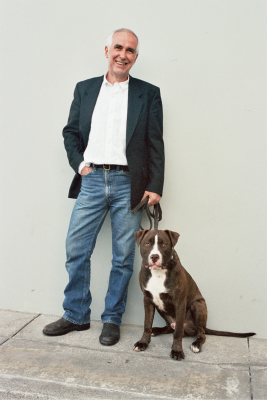Sit-Stay & Walk On-Leash

This is one of my all-time favorite training exercises — simply scary in simplicity and shocking in terms of magical results. This exercise actually provides the secret information that some gawdy websites promise over and over but never actually deliver. Watch our videos and see for yourself.
You start with an over-the-top, Iditarod-level leash-puller, who hasn’t paid attention to you for months, or years, and after just ten minutes fun training, you recreate your attentive dog who walks calmly on leash, looks up at you when you slow down and automatically sit-stays when you stop.
Until such a time as your dog is trained to your satisfaction, weigh out and use your dog’s daily allotment of kibble for this and other exercises. You may perform this exercise at home (indoors or outdoors) or on a walk.
Stand still, holding the leash in one hand and kibble in the other with both hands held high up and close to the body. Ignore everything your dog does until he sits. It doesn’t matter how long it takes. Eventually, your dog will sit. Many dogs will go through an entire repertoire of behaviors that worked in the past to make you walk. The dog may lunge into the leash, bark, circle and jump-up. Just stand still and ignore your dog’s unwanted antics. Wait for your dog to sit.
The longer your dog takes to sit, the better he learns that his previous attention-getting and leash-pulling antics no longer work. When he eventually sits and receives immediate praise and a piece of kibble, he will have a Eureka-experience. “Ahhhh! So sitting is the secret to get my owner to move forwards.”
As soon as your dog sits, immediately say, "Good dog," offer a food treat, and then take one huge step, stand still and wait for your dog to sit again. Your dog will likely explode to the end of the leash, thereby illustrating the reinforcing nature of you taking just one step. Wait for your dog to sit again. Most likely he will not take as long this time. When your dog sits, praise, offer a piece of kibble, take one big step and stand still once more. Repeat this sequence until your dog moves forward calmly (because he knows you are only going to take one step) and sits promptly when you stop and stand still.
Your dog has now learned he has the power to make you stop and the power to make you go. If he tightens the leash, or bounces and barks like the proverbial banana, you stop. But if he slackens the tension on the leash and sits, you take a step. After a series of single steps and standstills without pulling, try taking two steps at a time. Then go for three steps, then five, eight, twelve, and so on. Now you will find your dog will walk attentively on a loose leash and sit automatically whenever you stop. And the only words you have said were "Good dog."
Occasionally, stand still and delay giving the kibble for longer and longer periods. Praise your dog as he remains looking up at you in a sit-stay. Count out the length of the sit-stay in “good dogs”—“Good dog one. Good dog two. Good dog three, etc.”
Now we are going to teach the dog to walk by your left side. Repeat the one-step-and-sit sequence as before but this time, when you take the one big step, rotate clockwise or counterclockwise through 90, 180, or 270 degrees and stand still and wait for your dog to sit by your left side. (If you would like to walk your dog on your right side, that’s perfectly OK. Most trainers teach dogs to walk on the left.) Once your dog sits reliably by your left side each time you stop, start to thin out the food rewards and only reward the dog for straighter sits. Gradually and progressively increase the number of steps you take with each repetition. Now your dog is heeling when you walk and automatically sitting when you stop.
Alternate heeling and walking on-leash. For most of the walk, let your dog range and sniff on a loose leash, but every 25 yards or so, have your dog sit, heel, and sit, and then walk on again. Always sit-heel-sit your dog when crossing a street: sit before crossing, heel across, and then sit on the other side of the street.
Housetraining Tip
It is a good idea to have your dog eliminate before beginning a walk. It is so much easier to clean up and dispose of feces close to home. An empty dog will not pee over neighbors’ lawns or cause you to have to complete the walk carrying a plastic baggie of dog doo. To teach your dog to eliminate promptly, leave your house, stand still, instruct your dog, “Go pee, go poop,” and wait. When your dog pees, praise and offer kibble. Increase the length and enthusiasm of praise and the number of pieces of kibble according to the length of the pee. No praise for quick pretend pees, a “good dog” and a single piece of kibble for a two-second pee, “gooood dog” and two pieces of kibble for a three-second pee, etc. When your dog poops, celebrate with songs of praise and treats and say, “Walkies!” If your dog does not poop within three minutes, go back inside and walk your dog half an hour later. With a simple “no-poop-no walk” policy, you’ll soon have the speediest defecator on the planet.